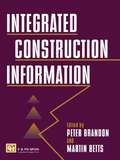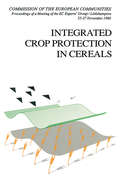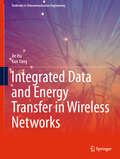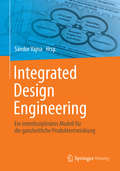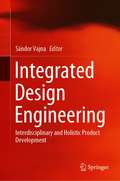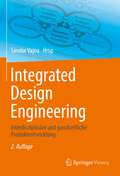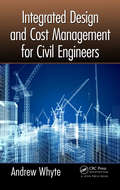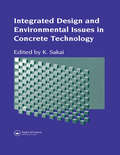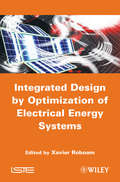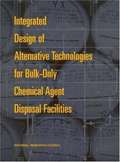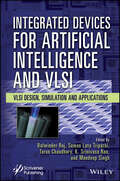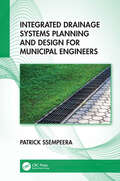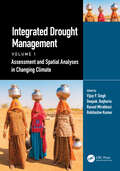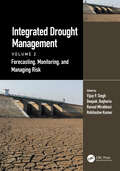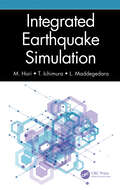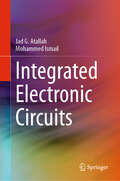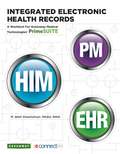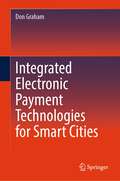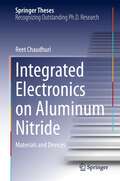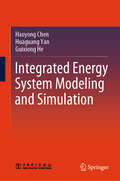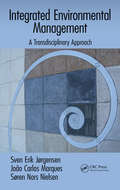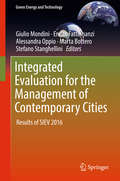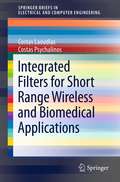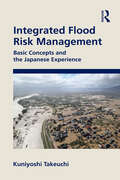- Table View
- List View
Integrated Construction Information
by P.S. Brandon M. Betts Martin Betts NfaThe construction industry is an information-intensive sector and low levels of productivity are often blamed on inadequate integration of information. This book shows how the different types and sources of information can be integrated to benefit individual construction projects, construction companies and in the construction industry at world-wide level.
Integrated Crop Protection
by P. GraffinThis book discusses the constraints on biological control ranging from the difficulty of convincing growers that they should infest their crops artificially to the effect of cultural techniques.
Integrated Crop Protection in Cereals
by R. CavalloroThis book contains 33 papers, presented at the meeting "Integrated Crop protection in Cereals", on recent developments in research into integral control of invertebrate pests, diseases and weeds, together with economic appraisals of applying such research to model farming systems.
Integrated Data and Energy Transfer in Wireless Networks (Textbooks in Telecommunication Engineering)
by Kun Yang Jie HuThis textbook offers a comprehensive guideline for integrated data and energy transfer, from theoretical fundamentals to practical implementations and applications. This book is suitable for students, engineers and scientists in electronic engineering who are interested in the integrated data and energy transfer in future wireless networks. The authors cover waveform and transceiver design in the physical layer, resource allocation and medium access control protocol, networking and deployment as well as practical implementation of the wireless integrated data and energy transfer. The authors commence from information theoretical fundamentals, physical layer design principles, medium access control, and networking techniques. The book ends with a practical prototype of integrated data and energy transfer. The book is geared towards graduate students and senior undergrads having a general background of wireless communications. The book features exercises, Q&A, and examples throughout.
Integrated Design Engineering
by Sándor VajnaDas vorliegende Buch beschreibt das Integrated Design Engineering (IDE). Dies ist die Weiterentwicklung der Integrierten Produktentwicklung (IPE) zu einem interdisziplin#65533;ren Modell f#65533;r eine ganzheitliche Produktentwicklung. Das IDE steht f#65533;r den systematischen Einsatz von integrierten, interdisziplin#65533;ren, ganzheitlichen und rechnerunterst#65533;tzten Strategien, Methoden und Werkzeugen bei der Entwicklung von Produkten und Dienstleistungen. Ber#65533;cksichtigt wird dabei der gesamte Lebenszyklus des Produkts. Das Werk erl#65533;utert die Grundlagen und den praktischen Einsatz des IDE, das sich in zahlreichen Industrieprojekten der beteiligten Autoren bereits als praxistauglich erwiesen hat. Es ist modular aufgebaut, so dass jedes Kapitel unabh#65533;ngig gelesen werden kann. Das Buch eignet sich f#65533;r * Studierende der Ingenieurwissenschaften, des Industriedesigns, der Wirtschaftswissenschaften, der Informatik und den sich hieraus ergebenden Br#65533;ckenstudieng#65533;ngen wie Sporttechniker oder Wirtschaftsingenieure. * Produktentwickler und F#65533;hrungskr#65533;fte aus der Praxis.
Integrated Design Engineering: Interdisciplinary and Holistic Product Development
by Sándor VajnaThis book addresses Integrated Design Engineering (IDE), which represents a further development of Integrated Product Development (IPD) into an interdisciplinary model for both a human-centred and holistic product development. The book covers the systematic use of integrated, interdisciplinary, holistic and computer-aided strategies, methods and tools for the development of products and services, taking into account the entire product lifecycle. Being applicable to various kinds of products (manufactured, software, services, etc.), it helps readers to approach product development in a synthesised and integrated way.The book explains the basic principles of IDE and its practical application. IDE’s usefulness has been demonstrated in case studies on actual industrial projects carried out by all book authors. A neutral methodology is supplied that allows the reader to choose the appropriate working practices and performance assessment techniques to develop their product quickly and efficiently. Given its manifold topics, the book offers a valuable reference guide for students in engineering, industrial design, economics and computer science, product developers and managers in industry, as well as industrial engineers and technicians.
Integrated Design Engineering: Interdisziplinäre und ganzheitliche Produktentwicklung
by Sándor VajnaDas vorliegende Buch beschreibt das Integrated Design Engineering (IDE). Dies ist die Weiterentwicklung der Integrierten Produktentwicklung (IPE) zu einem interdisziplinären Modell für eine ganzheitliche Produktentwicklung. Das IDE steht für den systematischen Einsatz von integrierten, interdisziplinären, ganzheitlichen und rechnerunterstützten Strategien, Methoden und Werkzeugen bei der Entwicklung von Produkten und Dienstleistungen. Berücksichtigt wird dabei der gesamte Lebenszyklus des Produkts.Das Werk erläutert die Grundlagen und den praktischen Einsatz des IDE, das sich in zahlreichen Industrieprojekten der beteiligten Autoren bereits als praxistauglich erwiesen hat.Es ist modular aufgebaut, so dass jedes Kapitel unabhängig gelesen werden kann.Das Buch eignet sich für• Studierende der Ingenieurwissenschaften, des Industriedesigns, der Wirtschaftswissenschaften, der Informatik und den sich hieraus ergebenden Brückenstudiengängen wie Sporttechniker oder Wirtschaftsingenieure.• Produktentwickler und Führungskräfte aus der Praxis.
Integrated Design and Cost Management for Civil Engineers
by Andrew WhyteFind Practical Solutions to Civil Engineering Design and Cost Management ProblemsA guide to successfully designing, estimating, and scheduling a civil engineering project, Integrated Design and Cost Management for Civil Engineers shows how practicing professionals can design fit-for-use solutions within established time frames and reliable budgets. This text combines technical compliance with practical solutions in relation to cost planning, estimating, time, and cost control. It incorporates solutions that are technically sound as well as cost effective and time efficient. It focuses on the integration of design and construction based on solid engineering foundations contained within a code of ethics, and navigates engineers through the complete process of project design, pricing, and tendering. Well illustratedThe book uses cases studies to illustrate principles and processes. Although they center on Australasia and Southeast Asia, the principles are internationally relevant. The material details procedures that emphasize the correct quantification and planning of works, resulting in reliable cost and time predictions. It also works toward minimizing the risk of losing business through cost blowouts or losing profits through underestimation. This Text Details the Quest for Practical Solutions That: Are cost effective Can be completed within a reasonable timeline Conform to relevant quality controls Are framed within appropriate contract documents Satisfy ethical professional procedures, and Address the client’s brief through a structured approach to integrated design and cost management Designed to help civil engineers develop and apply a multitude of skill bases, Integrated Design and Cost Management for Civil Engineers can aid them in maintaining relevancy in appropriate design justifications, guide work tasks, control costs, and structure project timelines. The book is an ideal link between a civil engineering course and practice.
Integrated Design and Environmental Issues in Concrete Technology
by K. SakaiThe two themes of integration of structural and durability design, and integration of concrete technologies in relation to global environmental issues are drawn together in this book. It presents the views of distinguished international researchers and engineers on these key topics as the 21st century approaches.
Integrated Design by Optimization of Electrical Energy Systems
by Xavier RoboamThis book proposes systemic design methodologies applied to electrical energy systems, in particular integrated optimal design with modeling and optimization methods and tools. It is made up of six chapters dedicated to integrated optimal design. First, the signal processing of mission profiles and system environment variables are discussed. Then, optimization-oriented analytical models, methods and tools (design frameworks) are proposed. A “multi-level optimization” smartly coupling several optimization processes is the subject of one chapter. Finally, a technico-economic optimization especially dedicated to electrical grids completes the book. The aim of this book is to summarize design methodologies based in particular on a systemic viewpoint, by considering the system as a whole. These methods and tools are proposed by the most important French research laboratories, which have many scientific partnerships with other European and international research institutions. Scientists and engineers in the field of electrical engineering, especially teachers/researchers because of the focus on methodological issues, will find this book extremely useful, as will PhD and Masters students in this field.
Integrated Design of Alternative Technologies for Bulk-Only Chemical Agent Disposal Facilities
by National Research CouncilA report on the Integrated Design of Alternative Technologies for Bulk-Only Chemical Agent Disposal Facilities
Integrated Devices for Artificial Intelligence and VLSI: VLSI Design, Simulation and Applications
by Suman Lata Tripathi Mandeep Singh Balwinder Raj K. Srinivasa Rao Tarun ChaudharyWith its in-depth exploration of the close connection between microelectronics, AI, and VLSI technology, this book offers valuable insights into the cutting-edge techniques and tools used in VLSI design automation, making it an essential resource for anyone seeking to stay ahead in the rapidly evolving field of VLSI design. Very large-scale integration (VLSI) is the inter-disciplinary science of utilizing advanced semiconductor technology to create various functions of computer system. This book addresses the close link of microelectronics and artificial intelligence (AI). By combining VLSI technology, a very powerful computer architecture confinement is possible. To overcome problems at different design stages, researchers introduced artificial intelligent (AI) techniques in VLSI design automation. AI techniques, such as knowledge-based and expert systems, first try to define the problem and then choose the best solution from the domain of possible solutions. These days, several CAD technologies, such as Synopsys and Mentor Graphics, are specifically created to increase the automation of VLSI design. When a task is completed using the appropriate tool, each stage of the task design produces outcomes that are more productive than typical. However, combining all of these tools into a single package offer has drawbacks. We can’t really use every outlook without sacrificing the efficiency and usefulness of our output. The researchers decided to include AI approaches into VLSI design automation in order to get around these obstacles. AI is one of the fastest growing tools in the world of technology and innovation that helps to make computers more reliable and easy to use. Artificial Intelligence in VLSI design has provided high-end and more feasible solutions to the difficulties faced by the VLSI industry. Physical design, RTL design, STA, etc. are some of the most in-demand courses to enter the VLSI industry. These courses help develop a better understanding of the many tools like Synopsis. With each new dawn, artificial intelligence in VLSI design is continually evolving, and new opportunities are being investigated.
Integrated Drainage Systems Planning and Design for Municipal Engineers
by Patrick SsempeeraUrban water management has to take an integrated approach that prioritizes sustainable drainage systems (SuDS) over gray infrastructure. This book elaborates on the planning and evaluation of pipework drainage systems with a focus on modern-day constraints to deliver a solution that favors sustainability as the overarching goal. The book includes a technical section on design of gray and green infrastructure, considering the total lifecycle costs of drainage systems. Advanced computer simulation techniques are discussed after covering the derivation of both standard and empirical equations for appropriate hydrology and hydraulics. The book provides an incorporation of reliability analyses for both green and gray infrastructure starting with techniques for forecasting flows, hydraulic performance, and lifecycle costs. The work also involves 3-D modeling, geospatial and big data analysis, and how these techniques are applied into city management—particularly beneficial to municipal engineers who are increasingly becoming involved in mapping the underground. Soil mechanics and subsurface drainage systems are analyzed and structural aspects of sewers are included. Finally, soil behavior in shear, retaining wall structures, and tunneling is briefly featured in the book. This book will be of interest to (under)graduate and postgraduate engineering students, drainage engineers, urban planners, architects, water engineers, developers, construction contractors, and municipal engineers.
Integrated Drought Management, Volume 1: Assessment and Spatial Analyses in Changing Climate (Drought and Water Crises)
by Vijay P. Singh, Deepak Jhajharia, Rasoul Mirabbasi and Rohitashw KumarThe first volume of this comprehensive global perspective on Integrated Drought Management is focused on understanding drought, causes, and the assessment of drought impacts. It explains different types of drought: agricultural, meteorological, hydrological, and socioeconomic droughts, their indices and the impact of climate change on drought. The volume also examines spatiotemporal analysis of drought, variability and patterns, assessment, and drought evaluation. With numerous case studies from India, Mexico, Turkey, Brazil, US, and other countries, this volume serves as a valuable resource for all readers who want to advance their knowledge on drought and risk management. Features: Provides a global perspective on drought prediction and management and a synthesis of the recent state of knowledge. Covers a wide range of topics from essential concepts and advanced techniques for forecasting and modeling drought to societal impacts, consequences, and planning. Presents numerous case studies with different management approaches from different regions and countries. Addresses how climate change impacts drought, the increasing challenges associated with managing drought, decision making, and policy implications. Includes contributions from hundreds of experts around the world. Professionals, researchers, academics, and postgraduate students with knowledge in environmental sciences, ecology, agriculture, forestry, hydrology, water resources engineering, and earth sciences, as well as those interested in how climate change impacts drought management, will gain new insights from the experts featured in this two-volume handbook.
Integrated Drought Management, Volume 2: Forecasting, Monitoring, and Managing Risk (Drought and Water Crises)
by Vijay P. Singh, Deepak Jhajharia, Rasoul Mirabbasi and Rohitashw KumarThe second volume of this comprehensive global perspective on Integrated Drought Management is focused on drought modeling, meteorological prediction, and the use of remote sensing in assessing, analyzing, and monitoring drought. It discusses risk management, planning, policy, and societal impacts of drought such as water pricing, water transfer, water quality, and crop insurance. Through numerous case studies from India, Iran, Brazil, the US, Nepal, and other countries that cover a broad range of topics and geographical regions, this volume serves as a valuable resource for all professionals, researchers, and academics who want to advance their knowledge about droughts. Features Provides a global perspective on drought prediction and management and a synthesis of the recent state of knowledge. Covers a wide range of topics from essential concepts and advanced techniques for forecasting and modeling drought to societal impacts, consequences, and planning Presents numerous case studies with different management approaches from different regions and countries. Addresses how climate change impacts drought, the increasing challenges associated with managing drought, decision-making, and policy implications. Includes contributions from hundreds of experts from around the world. Professionals, researchers, academics, and postgraduate students with knowledge in environmental sciences, ecology, agriculture, forestry, hydrology, water resources engineering, and earth sciences, as well as those interested in how climate change impacts drought management, will gain new insights from the experts featured in this two-volume handbook.
Integrated Earthquake Simulation
by M. Hori T. Ichimura L. MaddegedaraIntegrated earthquake simulation (IES) is a new method for evaluating earthquake hazards and disasters induced in cities and urban areas. It utilises a sequence of numerical simulations of such aspects as earthquake wave propagation, ground motion amplification, structural seismic response, and mass evacuation. This book covers the basics of numerical analysis methods of solving wave equations, analyzing structural responses, and developing agent models for mass evaluation, which are implemented in IES. IES makes use of Monte-Carlo simulation, which takes account of the effects of uncertainties related to earthquake scenarios and the modeling of structures both above and below ground, and facilitates a better estimate of overall earthquake and disaster hazard. It also presents the recent achievement of enhancing IES with high-performance computing capability that can make use of automated models which employ various numerical analysis methods. Detailed examples of IES for the Tokyo Metropolis Earthquake and the Nankai Trough Earthquake are given, which use large scale analysis models of actual cities and urban areas.
Integrated Electronic Circuits
by Mohammed Ismail Jad G. AtallahThis textbook takes a unique approach to fundamental courses in electronic circuits, providing the students with early exposure to Integrated Circuit (IC) technology and Electronic Design Automation (EDA) tools using a Process Design Kit (PDK). This aims at preparing the students to participate in the advancements taking place in the field today and in the foreseeable future. The book follows a novel, hands-on approach to electronics education, combining a unique pedagogy that balances theory with practice. The starting point consists of circuit simulation results rather than device physics. Therefore, hand calculations and simulations are readily used, and the loop between the two is closed. The information is presented visually not only for the circuits, but also for the signals involved, all of which being simulation results. The book is aimed to be easily read and understood by the students, which gives the instructors ample time to concentrate on the important points. The book discusses technology and its applications and limitations along with the IC design flow. It goes in depth into various types of circuits including analog, digital, and mixed-signal, where the students are encouraged to discover the connections between the different applications. This is because future electronic circuit designers should be able to understand system and technology aspects, and be able to switch easily between applications. This results in the students being better-prepared for future cross-disciplinary innovations.
Integrated Electronic Health Records: A Worktext For Greenway Medical Technologies' Primesuite
by M. Beth ShanholtzerIntegrated Electronic Health Records: An Online Course and Worktext for Greenway Medical Technologies' PrimeSUITE®. Developed as a comprehensive learning resource, this hands-on course is offered through McGraw-Hill's Connect Plus. Connect Plus uses the latest technology and adaptive learning techniques to better connect professors to their students, and students to the information and customized resources they need to master a subject. It includes a variety of digital learning tools that enable professors to easily customize courses and allow students to learn and master content and succeed in the course. Here's what you can expect from the Worktext: -A book meant to complement the online Connect Plus course, written by an author with an extensive HIM/HIT background--Beth Shanholtzer, MAEd, RHIA. -Coverage of Greenway Medical Technologies' PrimeSUITE, an ONC-ATCB-Certified, fully-integrated, online EHR, PM and interoperability solution. The book is not meant to be an extensive user manual for PrimeSUITE, but rather it covers the key topics for EHR, with PrimeSUITE as the vehicle to demonstrate those topics. Attention is paid to providing the "why" behind each task so that the reader can accumulate transferable skills. -Content that will be appealing to HIM programs, HIT programs, MIBC programs and more. All exercises are designated with PM, EHR, HIM tags, or some combination of those three. Instructors can access a correlation of the Worktext's Learning Outcomes to the key accrediting bodies such as CAHIIM, ABHES and CAAHEP via the book's website, www. mhhe. com/greenway.
Integrated Electronic Payment Technologies for Smart Cities
by Don GrahamThis book addresses the use of existing and emerging electronic payment technologies within a smart city in the context of the clear and proven value these systems have demonstrated in improving transportation. It addresses such question as How does the toll gantry work? How does it read the transponder tag and deduct the correct amount? How do cities harness the transaction data from mass transit to better meet the demand during peak hours? What can city planners do to make trip scheduling and payments seamless, so commuters can go from park-and-ride to mass transit to ride-share with a single payment platform? The volume is technical in nature and describes solid technical solutions to engineers and planners associated with smart cities initiatives. It is specifically designed to support smart city designers and engineers as they develop strategies that incorporate the latest payment system technologies. It will also be of value to private sector payment systems solution providers looking to deliver their products and services to smart cities. In addition, the book supplements technical perspectives with guidance on planning and implementation. For example, it defines procurement approaches for emerging technologies such as crypto currencies and block chain. Rounding out technical detail with advice on policy and the organizational framework required to underpin the technologies, the book delivers practical support to smart city technical practitioners. It further stands as an appropriate text for university courses associated with smart city planning, operations, and urban analytics. This book explores these questions and provides answers that a typical transportation planner can follow. It covers technology topics such as RFID (Radio Frequency ID), ETC (Electronic Toll collection), and ANPR (Automatic Number Plate Recognition). The book also delves into how contactless payment (Near-Field) technologies can be used in a smart city. Blockchain is introduced as a platform that is suitable for solving the problem of payment segregation and shows how the entities in a smart city can work together to provide a seamless payment solution for riders across different modes of transport. The book also covers some theoretical concepts of congestion pricing which students at the university level can apply to city planning projects and research into smart cities. Several examples of US-based and international smart city implementations are provided in the closing chapters which demonstrate new, innovative smart city techniques for the transportation planner.
Integrated Electronics on Aluminum Nitride: Materials and Devices (Springer Theses)
by Reet ChaudhuriThis thesis outlines the principles, device physics, and technological applications of electronics based on the ultra-wide bandgap semiconductor aluminum nitride. It discusses the basic principles of electrostatics and transport properties of polarization-induced two-dimensional electron and hole channels in semiconductor heterostructures based on aluminum nitride. It explains the discovery of high-density two-dimensional hole gases in undoped heterojunctions, and shows how these high conductivity n- and p-type channels are used for high performance nFETs and pFETs, along with wide bandgap RF, mm-wave, and CMOS applications. The thesis goes on to discuss how the several material advantages of aluminum nitride, such as its high thermal conductivity and piezoelectric coefficient, enable not just high performance of transistors, but also monolithic integration of passive elements such as high frequency filters, enabling a new form factor for integrated RF electronics.
Integrated Energy System Modeling and Simulation
by Haoyong Chen Huaguang Yan Guixiong HeThis book provides an in-depth introduction to the dynamic characteristics of Integrated Energy Systems (IES). It establishes a unified energy network model, elucidating the complementarities between various forms of energy, the conversion efficiencies, and the interactions and influences on operating costs. The book proposes methods for the planning, configuration, and operational control of IES and develops a simulation system for the integration of multi-physical field analog, hybrid transient, and steady-state conditions. The established mathematical models and simulation system are utilized to conduct a series of analyses under typical integrated energy scenarios. These analyses evaluate the operational performance and economic benefits of IES across different conditions. This book serves as a valuable resource for professionals involved in the research, planning, design, consulting, research and development, and operation of businesses related to integrated energy systems. It also serves as an essential reference for educators and college students.
Integrated Environmental Management: A Transdisciplinary Approach (Applied Ecology and Environmental Management)
by Søren Nors Nielsen Sven Erik Jörgensen Joao Carlos MarquesBased on 40 years of experience, Integrated Environmental Management: A Transdisciplinary Approach brings together many ecological and technological tool boxes and applies them in a transdisciplinary method. The book demonstrates how to combine continuous improvement management tools and principles with proven environmental assessment methodologies
Integrated Evaluation for the Management of Contemporary Cities: Results of SIEV 2016 (Green Energy and Technology)
by Stefano Stanghellini Marta Bottero Alessandra Oppio Giulio Mondini Enrico FattinnanziThis book highlights a selection of the best papers presented at the 2016 SIEV conference “The Laudato sì Encyclical Letter and Valuation. Cities between Conflict and Solidarity, Decay and Regeneration, Exclusion and Participation”, which was held in Rome, Italy, in April 2016, and brought together experts from a diverse range of fields – economics, appraisal, architecture, energy, urban planning, sociology, and the decision sciences – and government representatives. The book is divided into four parts: Human Ecology: Values and Paradigms; Integral Ecology and Natural Resource Management; Intergenerational Equity; and How to Enhance Dialogue and Transparency in Decision-making Processes. Cities are where 72% of all Europeans live, and this percentage is expected to rise to 80% by 2050. Given this trend towards urbanization, cities are continuously growing, which also entails a growing risk of social segregation, lack of security and mounting environmental problems. All too often, today’s cities have to cope with social and environmental crises, shifting the European urban agenda towards regeneration processes. Urban regeneration is more complex than merely renovating existing buildings, as it also involves social and environmental problems, inhabitants’ quality of life, protecting tangible and intangible cultural resources, innovation and business.
Integrated Filters for Short Range Wireless and Biomedical Applications
by Costas Psychalinos Costas LaoudiasThis book describes the design of low-voltage analog integrated filters using current mirrors, one of the most common building blocks both in analog and mixed-signal VLSI circuits, offering the advantages of low-voltage operation, derivation of resistorless topologies and electronic adjustment capability of their frequency characteristics. Several design examples are described, using current mirrors that fulfill the requirements of modern low-power wireless and biomedical applications, such as universal biquadratic filter topologies, complex filters for Bluetooth/ZigBee low-IF receivers and Wavelet filters for cardiac signal detection. The experimental results from the fabricated chips will also be presented, showing their utility in modern low-voltage low-power portable devices.
Integrated Flood Risk Management: Basic Concepts and the Japanese Experience
by Kuniyoshi TakeuchiThis book tackles the question of how we can manage flood-related disaster risks, such as from typhoons, monsoons, and torrential rain, which have been intensified by climate change and have generated unprecedented floods, landslides and debris flows worldwide. It presents recent conceptual developments in disasters, risk and resilience, and surveys UN policies on environment and development as well as disaster management. Sustainable and resilient development requires an integrated approach and human empowerment. Japan provides a useful example of effective flood management and disaster recovery in its current strategies for river and basin integrated flood management. Very few English-language books present up-to-date Japanese experiences for students and professionals in the context of global trends, relevant to a time of climate change and with global application. • Outlines an integrated approach to flood risk management in the context of UN initiatives • Details Japanese good practice developed through culture and the needs of a changing society Integrated Flood Risk Management is ideal for professionals working for environmental agencies, hydrologists and engineers, as well as students of disaster management and water resources development.
